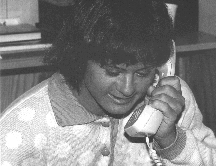Senior Lecturer in Speech Pathology
Leeds Metropolitan University, Leeds LS1 3HE
England
15 Old Ford Road
London E2 9PJ
020-8983 1003, Fax: 020-8983 3591
E-mail: mail@stammer.demon.co.uk
|
Monica Bray Senior Lecturer in Speech Pathology Leeds Metropolitan University, Leeds LS1 3HE England |
Reprinted with the permission of The British Stammering Association 15 Old Ford Road London E2 9PJ 020-8983 1003, Fax: 020-8983 3591 E-mail: mail@stammer.demon.co.uk |
 This text is designed to help people who have Down syndrome and
who care for and work with people who have Down syndrome to
understand the problem of dysfluency in speech. People with Down syndrome are born with an extra chromosome as a result of a genetic
accident before or around the time of conception1. This results
in a certain degree of learning difficulty which can affect the
ability to understand and produce speech and language. One of
the biggest problems for many people with Down syndrome is
the unintelligibility of their speech to others. Unintelligibility
and dysfluency go hand in hand. Many people with Down syndrome
are dysfluent and a few of these people also stutter, or stammer.
That is why it is important to understand the difference between
the two terms - dysfluency and stammering.
This text is designed to help people who have Down syndrome and
who care for and work with people who have Down syndrome to
understand the problem of dysfluency in speech. People with Down syndrome are born with an extra chromosome as a result of a genetic
accident before or around the time of conception1. This results
in a certain degree of learning difficulty which can affect the
ability to understand and produce speech and language. One of
the biggest problems for many people with Down syndrome is
the unintelligibility of their speech to others. Unintelligibility
and dysfluency go hand in hand. Many people with Down syndrome
are dysfluent and a few of these people also stutter, or stammer.
That is why it is important to understand the difference between
the two terms - dysfluency and stammering.
What is dysfluency and what is stuttering?
Not one of us is perfectly fluent. We all
hesitate and stumble over words; we pause to think; we go back
over what we've already said; we start a word and then change
it into another word; we 'um' and we 'er'. This lack of fluency
is normal for both adults and children, though in children it
tends to occur more frequently.
If these hesitancies and stumblings make speech difficult to understand, or if they occur too often or with too much effort, they may be seen a abnormal. In this case we may use the term 'dysfluency'.
Stuttering (or stammering) is the most common form of dysfluency and is the word most familiar to people. This word is correctly used when one or more of the following occur:
The speaker
The word 'dysfluency' may cover many of the same things but also includes:
The speech of people who are dysfluent may be hard to understand, it may seem to be jerky or disjointed, and it does not flow easily from one word to the next.
The Effect of Down Syndrome on Language and Fluency
It has been suggested by some experts2 that the process of producing language goes something like this:
| At any time we may notice and correct mistakes—this is called FEEDBACK |
 |
The idea is formed |
 |
The idea is converted into a language program |
|
 |
The language program is converted into a speech muscle movement program |
|
 |
The idea is spoken |
|
 |
The message is heard |
|
 |
The message is understood |
People with Down syndrome may find some or all of these steps particularly difficult. Ideas may not be clearly formed; the language plan and/or speech may be a problem. As well as this, hearing loss, which is quite common in people with Down syndrome, makes learning and understanding language difficult. also, the individual may lack the social awareness needed to know when or where it is appropriate to say what is wanted.
For all of us it is common to find that, as the pressure to speak and speak well builds, a breakdown in fluency may occur. Imagine that you a retrying to plan what to say in a foreign language—one where you only know a few words! You are likely to have long pauses when you are thinking of words; you might start a word, realize it's wrong and try another word; you may repeat a word a number of times while you are trying to plan the sentence. In fact you may appear very dysfluent!
For a person with Down syndrome, wanting to convey messages through a system that does not always work perfectly, may lead to:
Demands and Capacities
One of the experts in the field of dysfluency put forward the idea that fluency depends on an equal balance between demands made on the language system and the abilities (or capacities) of the individual which helps him or her to meet these demands3. Dysfluency occurs when demand exceeds capacities.
|
|
||
|
|
|
How can people with Down syndrome be helped?
Following on from the previous model, we can see how our aim is to try and balance the scales by decreasing demands and increasing capacities.
Decreasing demands:
Most children with Down syndrome will be particularly dysfluent while their language is developing and their vocabulary is expanding. The dysfluencies may pass or reduce as they become better planning and organizing their language. However, for some, language and speech may always be difficult.
 As adults, a number of people with Down syndrome will be quite difficult to understand at times and they
may have bouts of dysfluency varying from mild hesitancies to
more sever struggling to get words out. The most important thing
is that they should feel that what they say has value and that
others want to listen to them. Attempts to make people imitate
sentences or practise speaking in different ways are unlikely
to produce more fluent, clearer speech in the long run, and this
might make them feel that the payoffs for speaking are not worth
the effort.
As adults, a number of people with Down syndrome will be quite difficult to understand at times and they
may have bouts of dysfluency varying from mild hesitancies to
more sever struggling to get words out. The most important thing
is that they should feel that what they say has value and that
others want to listen to them. Attempts to make people imitate
sentences or practise speaking in different ways are unlikely
to produce more fluent, clearer speech in the long run, and this
might make them feel that the payoffs for speaking are not worth
the effort.
Conclusion
Do talk about the problems of dysfluency amongst
yourselves and with people who can help. Don't feel you can't
or mustn't say anything. By avoiding talking about the issues
you could be making yourself and the person who has the problem
feel worse about it.
Talk to a speech and language therapist - particularly one who has knowledge of Down syndrome or contact:
The Down's Syndrome AssociationReferences
155 Mitcham Road
London SW17 9PG
0181-682 4001, Fax: 0181-682 4012
| Source: | |
| http://www.stammering.org/downs.html | Revised: July 12, 1999. |